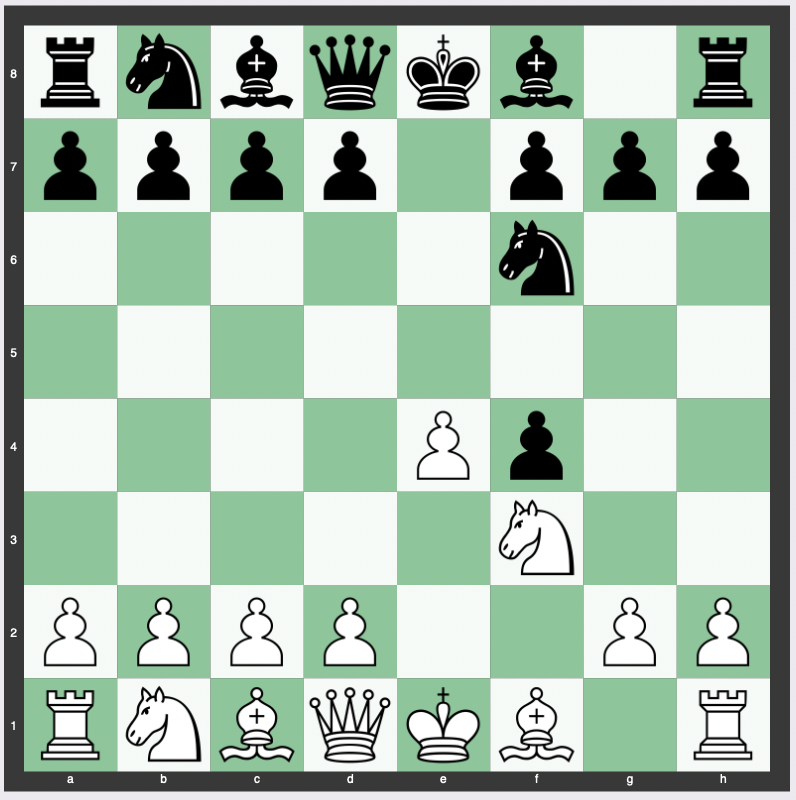Within the context of King’s Gambit theory, the Schallopp Defense has carved its own niche.
Named after the German chess master Emil Schallopp, this defense move is a lesser-known yet potent tool in the hands of skilled players.
It’s not the most frequently chosen strategy, but it rose to prominence in 2020 when the Chinese Grandmaster Ding Liren used it effectively to beat the World Champion Magnus Carlsen.
The Schallopp Defense starts with the move order: 1. e4 e5 2. f4 exf4 3. Nf3 Nf6
What is the Schallopp Defense?
In the context of chess openings, the Schallopp Defense refers to the move 3…Nf6.

Typically, it’s played with an intention of retaining control of the pawn after the subsequent moves 4.e5 Nh5.
Despite not being the most popular choice, the Schallopp Defense has a unique appeal due to its potential for tactical complexity.
Notable Game: Ding Liren vs. Magnus Carlsen
In 2020, the Schallopp Defense gained considerable attention when Ding Liren deployed it in the Magnus Carlsen Invitational online tournament.
A grand display of chess prowess, Liren’s strategic deployment of the Schallopp Defense secured him a decisive win over Carlsen.
Risks of the Schallopp Defense
The Schallopp Defense is not without its perils. The undefended knight at h5 necessitates cautious play.
In a sequence like 4.e5 Nh5 5.d4 d6 6.Qe2 Be7?, Black must be meticulous.
The correct move is 6…d5!=.
A faulty step like 7.exd6 Qxd6 8.Qb5+ can lead to the capture of the h5-knight, highlighting the risk element involved.
Evaluation of the Schallopp Defense
The Schallopp Defense is generally evaluated at around -0.45 to -0.60 for white.
Continuation Lines in the Schallopp Defense
In response to the Schallopp Defense, white will generally play 4. Nc3 (to develop normally) or 4. e5 (to attack the knight).
Both are about equally good moves.
4. Nc3
4. Nc3 d5 5. exd5 Nxd5 6. Nxd5 Qxd5 7. d4 Be7 8. Be2 g5 9. O-O O-O 10. h4 h6 11. hxg5 hxg5
4. Nc3 d5 5. exd5 Nxd5 6. Nxd5 Qxd5 7. d4 Be7 8. Bd3 Nc6 9. Bxf4 g5 10. Bg3 g4 11. Nd2 Nxd4 12. O-O Be6
4. Nc3 d5 5. exd5 Nxd5 6. Bb5+ c6 7. Qe2+ Be6 8. Nxd5 Qxd5 9. Ba4 Qd6 10. Bb3 Be7 11. d4 Nd7 12. Bxe6 fxe6 13. Bd2 O-O 14. O-O-O Rae8 15. Rhe1 Bd8
4. e5
4. e5 Nh5 5. Be2 d6 6. O-O Nc6 7. d4 g6 8. exd6 Bxd6 9. Nc3 O-O 10. Ne5 Nxe5 11. dxe5 Bxe5 12. Bxh5 gxh5 13. Bxf4 Bd4+ 14. Kh1 Bxc3 15. bxc3 Qxd1 16. Raxd1 Be6
4. e5 Nh5 5. Qe2 Be7 6. d4 O-O 7. Bd2 d5 8. Nc3 Bg4 9. O-O-O c6 10. Qf2 f6 11. Be2 fxe5 12. Nxe5 Bxe2 13. Qxe2 g6 14. Ng4
4. e5 Nh5 5. Qe2 Be7 6. d4 O-O 7. Nc3 d5 8. Bd2 Bg4 9. O-O-O c6 10. Qf2 f6 11. Ne2 fxe5 12. Nxe5 Be6 13. Qf3 g6 14. Nxf4
C34 King’s Gambit Accepted: Schallopp Defense
Conclusion
The Schallopp Defense, with its careful dance of retaining control and simultaneously managing risks, illustrates the inherent richness of chess strategy.
This defense is not for the faint-hearted. It requires deep understanding and calculation.
Though not commonly employed, when used effectively as showcased by Ding Liren in 2020, the Schallopp Defense can indeed be a formidable weapon.
As in every facet of chess, knowledge, practice, and execution are key to mastering this intriguing defense.


